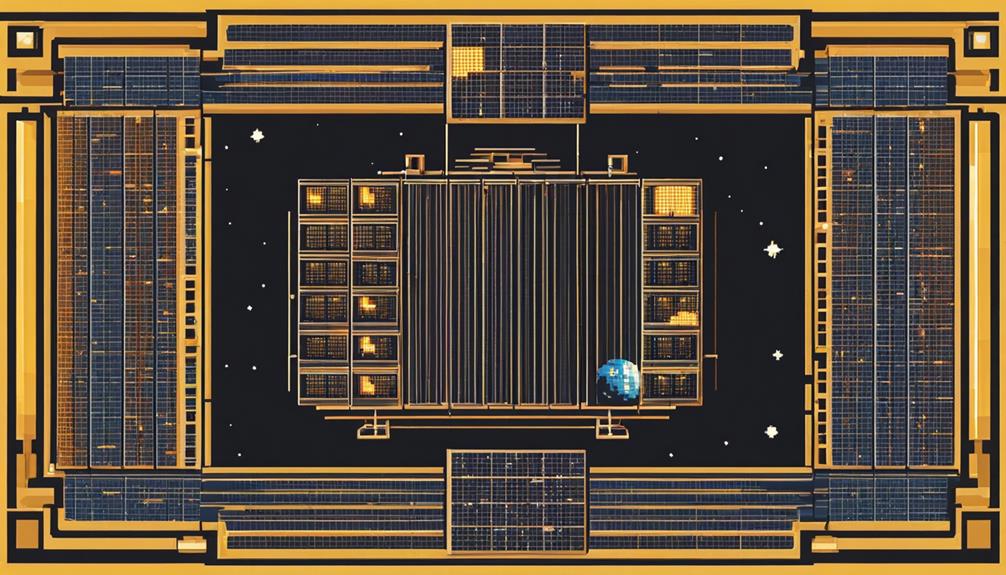The realm of satellite solar panel technologies stands as a testament to the meticulous evolution within the aerospace industry. From the inception of solar panels in the 1940s to the current era marked by Spectrolab's multi-junction cells, the journey has been one of incessant refinement and innovation. Gallium arsenide-based cells have emerged as stalwarts in the space environment, showcasing unparalleled resilience to radiation. As we unravel the complexities of material science, efficiency metrics, and future prospects, the discourse on satellite solar panel technologies beckons a deeper exploration into the pioneering strides shaping the cosmos.
Key Takeaways
- Gallium arsenide and silicon materials optimize satellite solar panel efficiency and durability.
- Multi-junction cells, including gallium arsenide, enhance space solar technology efficiency.
- Challenges like radiation exposure and thermal fluctuations drive innovation in satellite solar panel technologies.
- Sustainable satellite solar panels reduce environmental impact and promote clean energy practices in space missions.
Materials Used in Space Solar Panels
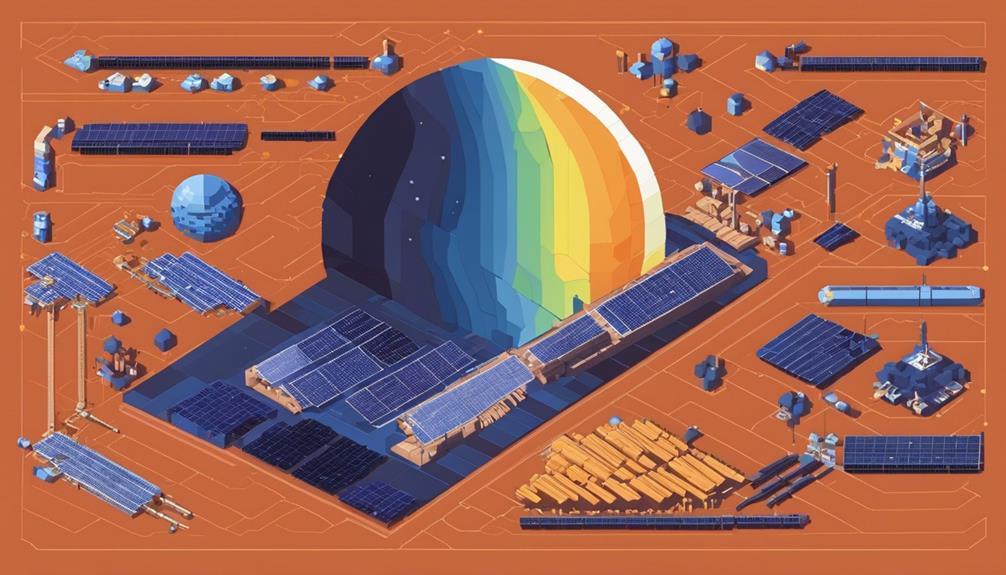
Space solar panels are predominantly constructed using gallium arsenide and silicon-based materials to optimize performance and durability in the harsh space environment. Gallium arsenide solar cells are particularly favored in space applications due to their higher efficiency and radiation resistance compared to silicon cells. These cells are known for their ability to convert sunlight into electricity efficiently, making them ideal for powering satellites and spacecraft.
In the space environment, where exposure to high levels of ionizing radiation is a constant threat, gallium arsenide solar cells exhibit superior radiation resistance, ensuring long-term reliability and functionality. Silicon-based solar cells, on the other hand, are often used in conjunction with borosilicate glass coverings to mitigate efficiency losses caused by ionizing radiation exposure. This protective layer helps shield the silicon cells from radiation damage, maintaining their performance over extended periods in space.
Moreover, the development of multi-junction solar cells has revolutionized space solar panel technology. By combining materials such as gallium arsenide, indium gallium phosphide, and germanium, these cells achieve exceptional efficiency levels, making them highly suitable for powering satellites and space missions where power generation is critical. The meticulous selection of materials based on factors like efficiency, durability, and radiation resistance underscores the importance of choosing the right components for space solar panels to ensure optimal performance and longevity in the demanding space environment.
Efficiency of Satellite Solar Technology
Multi-junction photovoltaic cells utilized in satellite solar technology demonstrate remarkable efficiencies, surpassing 39.2%. When exposed to the harsh space radiation environment, gallium arsenide cells exhibit slower degradation rates compared to silicon cells. The efficiency of satellite solar cells can experience an annual efficiency loss ranging from 5-10%, contingent upon the specific materials employed.
Solar Panel Advancements
Efficiency in satellite solar technology continues to advance through the utilization of multi-junction photovoltaic cells, which currently stand as the most efficient solar cells in production, achieving leading-edge efficiencies exceeding 39.2%. These cells, particularly those based on gallium arsenide, are preferred for space applications due to their slower degradation in the space radiation environment compared to silicon cells. Efficiency loss in solar panels due to radiation exposure can vary from 5-10% per year, with coverings of borosilicate glass helping to mitigate this loss. Innovations in space solar technology persistently aim to enhance the efficiency and durability of satellite solar panels, ensuring improved power generation for space missions.
Energy Conversion Rates
Advancements in satellite solar panel technologies have led to significant improvements in the energy conversion rates, shaping the efficiency of solar technology for space applications. Multi-junction photovoltaic cells, with efficiencies exceeding 39.2%, stand out as the most efficient solar cells currently in production. Gallium arsenide-based solar cells exhibit slower degradation in the space radiation environment compared to silicon cells, ensuring prolonged efficiency. However, efficiency loss in satellite solar panels due to radiation can vary from 5-10% annually, contingent on the materials utilized. To mitigate this, covering the panels with borosilicate glass can help reduce efficiency loss over time, thereby enhancing overall performance. Ongoing advancements in satellite solar technology persistently aim to enhance energy conversion rates and overall efficiency for space applications.
Impact of Space Environment on Solar Panels
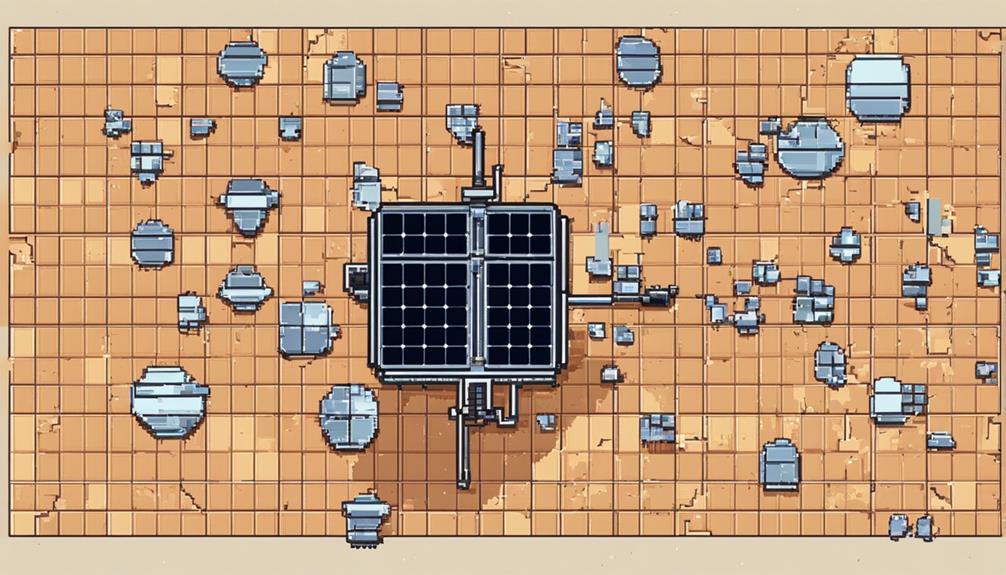
Solar panels deployed in space are subjected to the harsh space radiation environment, leading to efficiency degradation over time. In addition to radiation effects, thermal cycling poses a significant challenge to the longevity of solar panels in space. Understanding and mitigating these factors are crucial for maintaining optimal performance of solar panels on satellites.
Space Radiation Effects
Exposure to space radiation poses a significant challenge to the longevity and performance of solar panels utilized in satellite applications. Space radiation, particularly ionizing radiation, can lead to efficiency degradation in solar panels over time. Efficiency loss due to radiation exposure can range from 5-10% per year, depending on the materials used in the solar panels. To mitigate this effect, covering solar panels with borosilicate glass has been found to be effective. Gallium arsenide-based solar cells demonstrate slower degradation in the space radiation environment compared to silicon cells. Additionally, multi-junction photovoltaic cells incorporating materials like indium gallium phosphide and germanium exhibit greater resistance to radiation-induced efficiency loss, making them advantageous for satellite solar panel applications.
Thermal Cycling Challenges
How does the extreme thermal cycling experienced in the space environment impact the structural integrity and performance of satellite solar panels? Solar panels are subjected to significant temperature variations in space, ranging from -150°C in shadow to 150°C in sunlight. This thermal cycling induces expansion and contraction of materials, resulting in mechanical stress that can potentially damage the solar cells. To mitigate these challenges, materials used in solar panels must be carefully selected to withstand such extreme temperature fluctuations. Additionally, proper insulation and thermal management systems are crucial to protect the solar panels from thermal stress and ensure optimal performance over an extended period. Understanding the effects of thermal cycling is paramount in designing resilient and efficient satellite power systems.
- Solar panels experience extreme temperature variations in space.
- Thermal cycling causes expansion and contraction of materials.
- Materials selection is critical to withstand temperature fluctuations.
- Insulation and thermal management systems are essential for protection.
Innovations in Satellite Solar Panel Design
In the realm of satellite technology, recent advancements in solar panel design have been centered on enhancing power generation efficiency per unit area through innovative engineering solutions. These innovations aim to maximize the utilization of solar power in space, where traditional energy sources are not viable. New technologies are being developed to reduce the mass of satellite solar panels, improving the overall efficiency of solar technology in space missions. Advances in composite support structures have also been crucial in enhancing the strength and durability of satellite solar panels, ensuring their longevity in harsh space environments.
| Innovation | Description |
|---|---|
| Flexible Substrates | Incorporating flexible substrates in solar panel design increases versatility in deployment, adapting to various shapes and sizes. |
| Tracking Mechanisms | Cutting-edge developments in tracking mechanisms ensure optimal orientation of satellite solar panels towards the Sun for maximum energy absorption. |
| Lightweight Materials | Utilizing lightweight materials helps reduce the overall mass of solar panels, improving efficiency without compromising structural integrity. |
These innovations represent the forefront of satellite solar panel design, pushing the boundaries of efficiency and reliability in space applications. By harnessing these advancements, the future of solar technology in space looks promising, offering sustainable energy solutions for various satellite missions.
Challenges in Deploying Solar Panels in Space
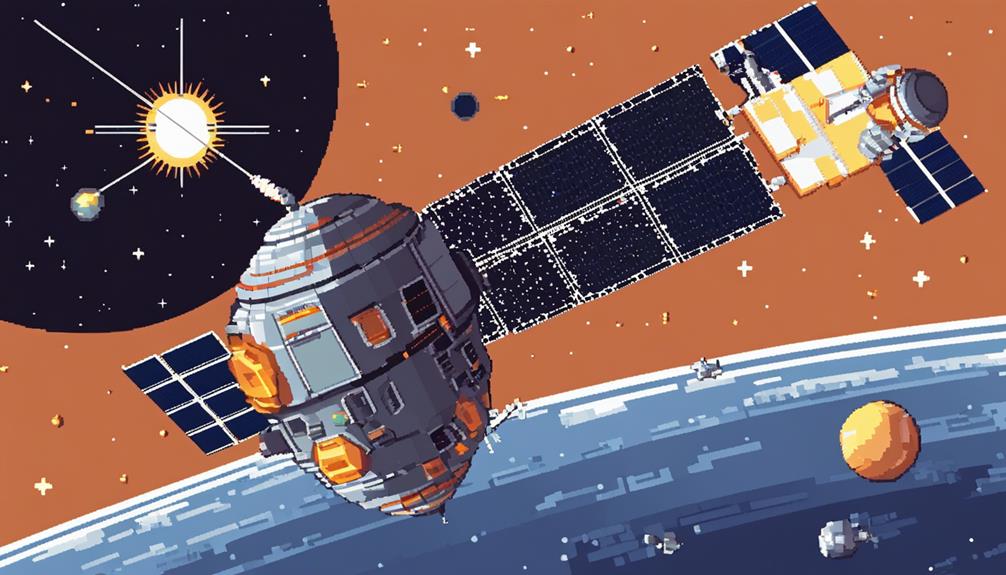
Efficient deployment of solar panels in space poses significant challenges due to the detrimental effects of ionizing radiation on their performance over time. Ionizing radiation encountered in space can lead to efficiency loss in solar panels, impacting their ability to generate electricity effectively. To address these challenges, several considerations need to be taken into account:
- Radiation Exposure: Solar panels in space are constantly bombarded by ionizing radiation, which can penetrate and degrade their materials over time.
- Efficiency Degradation: The exposure to ionizing radiation can cause solar panels to experience efficiency loss, leading to reduced power generation capabilities.
- Material Selection: Choosing the right materials, such as gallium arsenide cells that degrade more slowly than silicon cells, is crucial in mitigating efficiency loss due to radiation exposure.
- Mitigation Strategies: Implementing mitigation strategies like using borosilicate glass coverings or advanced material designs can help minimize the impact of ionizing radiation on solar panel efficiency.
Comparison of Different Solar Cell Types in Satellites
Given the challenges posed by ionizing radiation in space and the impact on solar panel efficiency, a critical aspect in satellite technology is the comparison of different solar cell types for optimal performance. Gallium arsenide solar cells have gained preference over silicon cells in space applications due to their enhanced radiation resistance, degrading more slowly in the harsh space environment. This slower degradation makes gallium arsenide cells more reliable for extended satellite missions, where consistent energy production is crucial.
Another significant advancement in satellite solar cell technology is the development of multi-junction photovoltaic cells. These cells combine materials like indium gallium phosphide, gallium arsenide, and germanium to create the most efficient solar cells available for satellites. With leading-edge multi-junction cells achieving efficiencies exceeding 39.2%, they are ideal for high-performance satellite missions where power generation is a critical factor.
Efficiency loss in solar cells due to radiation in space is a notable consideration, with degradation rates typically ranging from 5-10% per year depending on the cell materials. The superior radiation resistance and high efficiencies of gallium arsenide and multi-junction cells make them top choices for satellite applications, ensuring reliable power generation over extended periods in the demanding space environment.
Maintenance Considerations for Satellite Solar Panels

Maintenance of satellite solar panels plays a vital role in ensuring long-term efficiency and performance in space missions. Regular cleaning is essential to maintain optimal efficiency and performance. Monitoring solar panel health through diagnostics and data analysis helps in identifying and addressing issues promptly. Implementing protective coatings on solar panels can help mitigate degradation caused by space radiation. Conducting periodic inspections for physical damage or degradation ensures longevity and reliability of satellite solar panels. Proper thermal management systems are crucial to prevent overheating and ensure consistent power generation. By adhering to these maintenance considerations, satellite operators can maximize the lifespan of solar panels and optimize power generation efficiency in the demanding environment of space. The combination of regular cleaning, monitoring, protective coatings, and inspections forms a comprehensive maintenance strategy that is essential for the sustained operation of satellite solar panels. These practices not only enhance the overall performance of solar panels but also contribute to the success of space missions by ensuring a stable and reliable power supply.
Advances in Power Generation From Space Solar Panels
Recent advancements in space solar panel technologies have propelled the efficiency of solar panels to unprecedented levels, surpassing 39.2% with the use of multi-junction cells. This increased efficiency, coupled with the resilience of gallium arsenide-based cells in the harsh radiation environment of space, signifies a promising future for power generation from space solar panels. As innovations continue to focus on reducing mass and elevating power output per unit area, the trajectory points towards enhanced capabilities for upcoming space missions.
Efficiency of Solar Panels
Advancements in solar panel technologies, particularly the utilization of multi-junction photovoltaic cells, have significantly enhanced the efficiency of power generation from space solar panels, with current production cells achieving efficiencies exceeding 39.2%.
- Multi-junction photovoltaic cells are the most efficient solar cells in production.
- Gallium arsenide-based solar cells degrade more slowly than silicon cells in the space radiation environment.
- Efficiency loss due to radiation in space can range from 5-10% per year, depending on the materials used.
- Covering solar panels with borosilicate glass can reduce efficiency loss over time.
These advancements in efficiency are crucial for maximizing power generation from space solar panels while mitigating the impact of space radiation on cell performance.
Future Applications and Trends
With a focus on enhancing efficiency and power generation capabilities, ongoing developments in solar panel technologies for space applications are driving advancements in the utilization of thin-film photovoltaic cells and flexible substrates. Future applications aim to increase solar array efficiency by incorporating these innovative technologies, such as silicon cells on flexible substrates, to maximize power generation per unit area while reducing overall mass. Additionally, composite support structures are being developed to enhance the strength-to-weight ratio of solar panels, ensuring durability in space environments. Standardization efforts in design and integration processes are underway to streamline the implementation of satellite solar panels, aiming for improved reliability and affordability for future missions. These trends signify a promising future for space solar panel technology, with a strong emphasis on performance and efficiency.
Future Trends in Satellite Solar Technologies
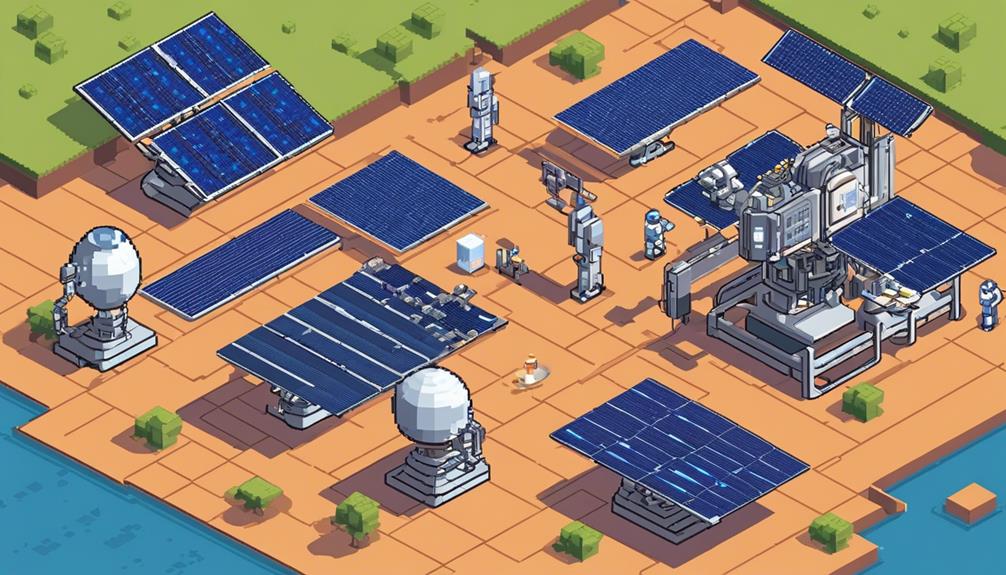
An evolution in satellite solar technologies is underway, focusing on the integration of advanced materials such as gallium arsenide to enhance efficiency and durability. Researchers are actively exploring ways to reduce the mass of solar arrays while simultaneously increasing power generation per unit area for future spacecraft applications. To drive innovation in satellite solar panel technologies, the integration of thin-film photovoltaic cells, flexible substrates, and composite support structures is being extensively studied. Moreover, standardization efforts are in progress to streamline the design and production of satellite solar panels, aligning with the evolving demands of the market.
- Advanced materials like gallium arsenide are being incorporated to improve efficiency and durability.
- Research is concentrated on reducing solar array mass while enhancing power generation per unit area.
- Thin-film photovoltaic cells, flexible substrates, and composite support structures are being integrated for innovation.
- Standardization initiatives aim to optimize the design and production processes of satellite solar panels to meet market needs efficiently.
Sustainability Aspects of Satellite Solar Panels
How do satellite solar panels contribute to the sustainability of spacecraft operations through the utilization of renewable energy sources? Satellite solar panels play a crucial role in enhancing the sustainability of spacecraft operations by harnessing solar power through the use of specialized satellite cells. By converting sunlight into electricity, these panels provide a clean energy source that significantly reduces the reliance on non-renewable energy sources for powering systems in space.
The integration of solar panels on satellites not only ensures a more sustainable approach to space missions but also helps in minimizing the environmental impact associated with traditional energy sources. Sustainability aspects of satellite solar panels extend to reducing carbon emissions and promoting clean energy practices in space exploration. This transition towards clean energy sources like solar power contributes to the long-term sustainability of space missions by leveraging renewable energy from the Sun to power critical spacecraft systems.
Frequently Asked Questions
What Is the Latest Technology in Solar Panels?
The latest breakthroughs in solar panels have revolutionized energy efficiency, particularly in space applications. Thin film technology has enabled the development of flexible panels, enhancing versatility and adaptability. Solar tracking systems have seen significant advancements, optimizing power generation. These innovations have propelled solar efficiency to unprecedented levels, setting new standards in sustainable energy solutions. The continuous evolution of solar panel technology promises even greater advancements in the field of renewable energy.
What Is Satellite Based Solar Power System?
A space-based solar power system, also known as a satellite-based solar power system, refers to the utilization of photovoltaic cells in space to capture solar energy. These systems are designed to be energy-efficient, providing continuous power by converting sunlight into electrical energy. They enable remote monitoring capabilities for efficient management. Advanced semiconductor materials are being explored for enhanced solar cell efficiency in space applications, reflecting ongoing research and development efforts by space agencies like NASA.
What Is the Best Solar Panel Technology in the World?
The best solar panel technology in the world today is multi-junction photovoltaic cells, which can achieve efficiencies exceeding 39.2%. These cells, using materials like indium gallium phosphide and gallium arsenide, are highly sought after for their superior performance. Continuous advancements in multi-junction cell technology aim to increase efficiency and power generation capabilities for future missions, making them a top choice for applications requiring high efficiency and reliability.
What Are the Three Solar Technologies?
Solar technologies encompass a range of methods for harnessing solar energy. Three primary solar technologies are crystalline silicon, thin-film, and concentrated solar power. Crystalline silicon cells dominate the market due to their efficiency and reliability. Thin-film technologies offer flexibility and cost-effectiveness, while concentrated solar power systems use mirrors to focus sunlight for power generation. Ongoing research in materials and tracking systems continues to drive innovation for future advancements in solar technology.
